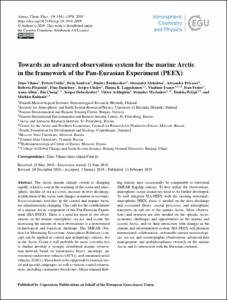| dc.contributor.author | Vihma, Timo | |
| dc.contributor.author | Uotila, Petteri | |
| dc.contributor.author | Sandven, Stein | |
| dc.contributor.author | Pozdnyakov, Dmitry | |
| dc.contributor.author | Makshtas, Alexander | |
| dc.contributor.author | Pelyasov, Alexander | |
| dc.contributor.author | Pirazzini, Roberta | |
| dc.contributor.author | Danielsen, Finn | |
| dc.contributor.author | Chalov, Sergey | |
| dc.contributor.author | Lappalainen, Hanna K. | |
| dc.contributor.author | Ivanov, Vladimir | |
| dc.contributor.author | Frolov, Ivan | |
| dc.contributor.author | Albin, Anna | |
| dc.contributor.author | Cheng, Bin | |
| dc.contributor.author | Dobrolyubov, Sergey | |
| dc.contributor.author | Arkhipkin, Viktor | |
| dc.contributor.author | Myslenkov, Stanislav | |
| dc.contributor.author | Petaja, Tuukka | |
| dc.contributor.author | Kulmala, Markku | |
| dc.coverage.spatial | Arctic Ocean | en_US |
| dc.date.accessioned | 2023-04-20T05:35:24Z | |
| dc.date.available | 2023-04-20T05:35:24Z | |
| dc.date.issued | 2019 | |
| dc.identifier.citation | Vihma, T., Uotila, P., Sandven, S., Pozdnyakov, D., Makshtas, A., et al (2019) Towards an advanced observation system for the marine Arctic in the framework of the Pan-Eurasian Experiment (PEEX). Atmospheric Chemistry and Physics, 19, pp.1941–1970. DOI: https://doi.org/10.5194/acp-19-1941-2019 | en_US |
| dc.identifier.uri | https://repository.oceanbestpractices.org/handle/11329/2184 | |
| dc.description.abstract | The Arctic marine climate system is changing rapidly, which is seen in the warming of the ocean and atmosphere, decline of sea ice cover, increase in river discharge, acidification of the ocean, and changes in marine ecosystems. Socio-economic activities in the coastal and marine Arctic are simultaneously changing. This calls for the establishment of a marine Arctic component of the Pan-Eurasian Experiment (MA-PEEX). There is a need for more in situ observations on the marine atmosphere, sea ice, and ocean, but increasing the amount of such observations is a pronounced technological and logistical challenge. The SMEAR (Station for Measuring Ecosystem-Atmosphere Relations) concept can be applied in coastal and archipelago stations, but in the Arctic Ocean it will probably be more cost-effective to further develop a strongly distributed marine observation network based on autonomous buoys, moorings, autonomous underwater vehicles (AUVs), and unmanned aerial vehicles (UAVs). These have to be supported by research vessel and aircraft campaigns, as well as various coastal observations, including community-based ones. Major manned drift-ing stations may occasionally be comparable to terrestrial SMEAR flagship stations. To best utilize the observations, atmosphere-ocean reanalyses need to be further developed. To well integrate MA-PEEX with the existing terrestrialatmospheric PEEX, focus is needed on the river discharge and associated fluxes, coastal processes, and atmospheric transports in and out of the marine Arctic. More observations and research are also needed on the specific socioeconomic challenges and opportunities in the marine and coastal Arctic, and on their interaction with changes in the climate and environmental system. MA-PEEX will promote international collaboration; sustainable marine meteorological, sea ice, and oceanographic observations; advanced data management; and multidisciplinary research on the marine Arctic and its interaction with the Eurasian continent. | en_US |
| dc.language.iso | en | en_US |
| dc.rights | Attribution 4.0 International | * |
| dc.rights.uri | http://creativecommons.org/licenses/by/4.0/ | * |
| dc.subject.other | Ice mass balance | en_US |
| dc.subject.other | Sea ice | en_US |
| dc.subject.other | Atmospheric boundary layer | en_US |
| dc.subject.other | Air Sea interaction | en_US |
| dc.subject.other | Atmosphere-ocean | en_US |
| dc.title | Towards an advanced observation system for the marine Arctic in the framework of the Pan-Eurasian Experiment (PEEX). | en_US |
| dc.type | Journal Contribution | en_US |
| dc.description.refereed | Refereed | en_US |
| dc.format.pagerange | pp.1941-1970 | en_US |
| dc.identifier.doi | http://dx.doi.org/10.5194/acp-19-1941-2019 | |
| dc.subject.parameterDiscipline | Meteorology | en_US |
| dc.subject.dmProcesses | Data aggregation | en_US |
| dc.subject.dmProcesses | Data analysis | en_US |
| dc.bibliographicCitation.title | Atmospheric Chemistry and Physics | en_US |
| dc.bibliographicCitation.volume | 19 | en_US |
| dc.bibliographicCitation.issue | 3 | en_US |
| dc.description.sdg | 14.a | en_US |
| dc.description.methodologyType | Reports with methodological relevance | en_US |
| obps.contact.contactname | Timo Vihma | |
| obps.contact.contactemail | timo.vihma@fmi.fi | |
| obps.resourceurl.publisher | https://acp.copernicus.org/articles/19/1941/2019/ | |
 Repository of community practices in Ocean Research, Applications and Data/Information Management
Repository of community practices in Ocean Research, Applications and Data/Information Management

